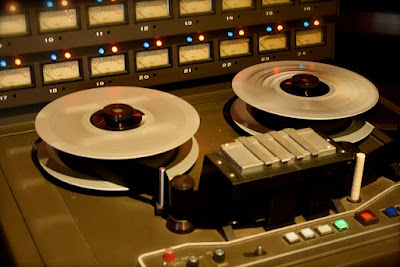In the Works, part 1
This is episode 1 of what I expect will be an ongoing series discussing current album recording projects. This entry will discuss the pros and cons of the two currently-used recording methods and processes.
I am blessed to work with some of the finest musicians in the world. Literally, as most of my artistic partners and collaborators are rather international: London, Budapest, Paris, Estonia, and even Tehran.
The album recording process ideally takes place in a recording studio with all musicians present. However, those logistics become challenging when the artists live in different countries. Fortunately, all my partners have their own recording studios in their home, as do I. That makes it easier to collaborate over long distances, as multi-track master recordings can be sent back and forth, with each person adding their parts. I used to consider this "remote recording," or "remote tracking" process to be a compromise; not as effective as a live, real-time recording session where everyone is present in the recording studio. But after doing several remote album projects, I've come to see the remote approach as equally valid as a live-in-the-studio session. And in some cases, superior.
The advantages to remote tracking have revealed themselves over time. One advantage is that it's an entirely different approach than live recording. Obviously. The first person will create a composition, record his parts, and then send that multi-track master recording to the next person for him to add his parts at a later time. Because this tracking process does not occur in real-time, that means that each person has far more time to consider each piece, more time to determine their parts for each piece, and more time to plan the overall composition. None of that can happen in a live studio.
In a live studio, it is essentially a live performance just as you'd see and hear in a concert. The differences are that the only audience is the recording engineer, and the atmosphere is much different than a live concert. You can of course scrap a take and start over, but in my experience with my partners, that almost never happens. The goal for me is to capture that live performance in a single take, start to finish. That kind of performance contains a lot of fire.
That's not to say that a remote recording project doesn't or can't have that kind of energy; they can and do. I suppose a succinct summation is to state that both methods are equally valid, and that the end result of both is also equally valid. Think of it as two paths leading to the same destination.
Remote tracking projects have another strong advantage: I can now work on multiple recording projects simultaneously. Whereas a live recording session takes place over a one- or two-day period, remote projects have no time limit. They can be done in weeks or months. This means that while one of my partners is working on his parts for project A, I can be tracking my parts for project B. It took me a while to wrap my head around this kind of workflow; of being able to split my consciousness to focus on more than one album project. A recording project for me is very demanding and nearly all-consuming. But as I've learned the workflow and the lifecycle of remote projects, I find that I can not only work on more than one at the same time, but several. At the time of this writing, I have seven album projects underway and in various stages of completion. I'll likely be discussing various current projects in future In the Works installments.
If you would have asked me a few years ago of my preference for live-in-the-studio or remote recording sessions, I would have proclaimed the live option to be far superior. I no longer think that's true.
-kk



Glad to see you've got this started. Love the cover art and wonder if your preference from live to studio is due primarily to those very advances that the digital age has lent to music in the broad spectrum in general? So much more is available in all ways from recording to performing, etc. Just asking for a friend ;) Hullo Kevin, good to see you here but wish there was a way to subscribe via YouTube.
ReplyDelete